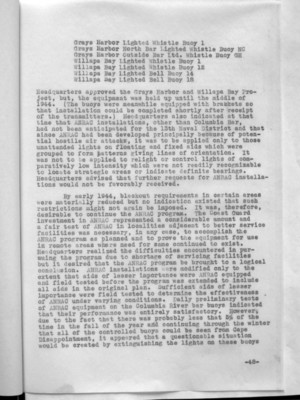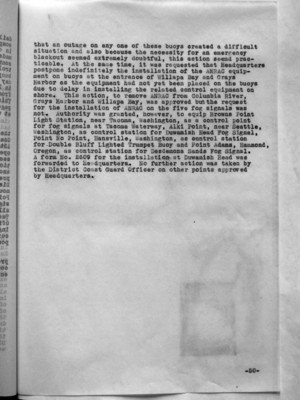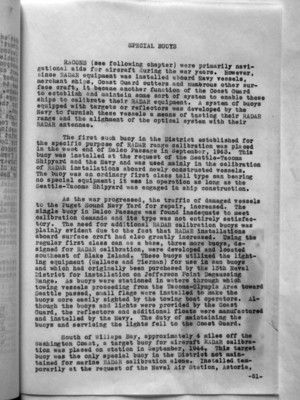Pages That Mention Willapa Bay
Coast Guard District narrative histories 1945
68
Grays Harbor Lighted Whistle Buoy 1 Grays Harbor North Bar Lighted Whistle Buoy NC Grays Harbor Outside Bar Ltd. Whistle Buoy GH Willapa Bay Lighted Whistle Buoy 1 WIllapa Bay Lighted Whistle Buoy 12 Willapa Bay Lighted Bell Buoy 14 Willapa Bay Lighted Bell Buoy 18
Headquarters approved the Grays Harbor and Willapa Bay Project, but, the equipment was held up until the middle of 1944. (The buoys were meanwhile equipped with brackets so that installation could be completed shortly after receipt of the transmitters.) Headquarters also indicated at that time that ANRAC installations, other than Columbia Bar, had not been anticipated for the 13th Naval District and that since ANRAC had been developed principally because of potential hostile air attacks, it was to be applied only to those unattended lights on floating and fixed aids which were grouped to form patterns giving lines of orientation. It was not to be applied to relight or control lights of comparatively low intensity which were not readily recognizable to locate strategic areas or indicate definite bearings. Headquarters advised that further requests for ANRAC installations would not be favorably received.
By early 1944, blackout requirements in certain areas were materially reduced but no indication existed that such restrictions might not again be imposed. It was, therefore, desirable to continue the ANRAC program. The Coast Guard investment in ANRAC represented a considerable amount and a fair test of ANRAC in localities adjacent to better service facilities was necessary, in any case, to accomplish the ANRAC program as planned and to prove the equipment for use in remote areas where need for same continued to exist. Headquarters realized the difficulties encountered in pursuing the program due to shortage of servicing facilities but it desired that the ANRAC program be brought to a logical conclusion. ANRAC installations were modified only to the extent that aids of lesser importance were ANRAC equipped and field tested before the program was extended to include all aids in the original plan. Sufficient aids of lesser importance were field tested to determine the effectiveness of ANRAC under varying conditions. Daily preliminary tests of ANRAC equipment on the Columbia River bar buoys indicated that their performance was entirely satisfactory. However, due to the fact that there was probably less that 5% of the time in the fall of the year and continuing through the winter that all of the controlled buoys could be seen from Cape Disappointment, it appeared that a questionable situation would be created by extinguishing the lights on these buoys
-48-
70
that an outage on any one of these buoys created a difficult situation and also because the necessity for an emergency blackout seemed extremely doubtful, this action seemed practicable. At the same time, it was requested that Headquarters postpone indefinitely the installation of the ANRAC equipment on buoys at the entrance of Willapa Bay and Grays Harbor as the equipment had not yet been placed on the buoys due to delay in installing the related control equipment on shore. This action, to remove ANRAC from Columbia River, Grays Harbor and Willapa Bay, was approved but the request for the installation of ANRAC on the five fog signals was not. Authority was granted, however, to equip Browns Point Light Station, newar Tacoma, Washington, as a control point for fog signals at Tacoma Waterway, Alki Point, near Seattle, Washington, as control station for Duwamish Head Fog Signal, Point No Point, Hansville, Washington, as control station for Double Bluff Lighted Trumpet Buoy and Point Adams, Hammond, Oregon, as control station for Desdemona Sands Fog Signal. A form No. 2609 for the installation at Duwamish Head was forwarded to Headquarters. No further action was taken by the District Coast Guard Officer on other points approved by Headquarters.
-50-
71
SPECIAL BUOYS
RACONS (see following chapter) were primarily navigational aids for aircraft during the war years. However, since RADAR equipment was installed aboard Navy vessels, merchant ships, Coast Guard cutters and numerous other surface craft, it became another function of the Coast Guard to establish and maintain some sort of system to enable these ships to calibrate their RADAR equipment. A system of buoys equipped with targets or reflectors was developed by the Navy to furnish these vessels a means of testing their RADAR range and the alignment of the optical system with their RADAR antennae.
The first such buoy in the District established for the specific purpose of RADAR range calibration was placed in the west end of Dalco Passage in September, 1943. This buoy was installed at the request of the Seattle-Tacoma Shipyard and the Navy and was used mainly in the calibration of RADAR installations aboard newly constructed vessels. The buoy was an ordinary first class tall type can bearing no special equipment; it was in operation as long as the Seattle-Tacoma Shipyard was engaged in ship construction.
As the war progressed, the traffic of damaged vessels to the Puget Sound Navy Yard for repair, increased. The single buoy in Dalco Passage was found inadequate to meet calibration demands and its type was not entirely satisfactory. The need for additional RADAR calibration buoys was plainly evident due to the fact that RADAR installations aboard surface craft had also greatly increased. Using the regular first class can as a base, three more buoys, designed for RADAR calibration, were developed and located southeast of Blake Island. These buoys utilized the lighting equipment (Wallace and Tiernan) for use in can buoys and which had originally been purchased by the 13th Naval District for installation on Jefferson Point Degaussing Range. As buoys were stationed in waters through which towing vessels proceeding form the Tacoma-Olympia Area toward Seattle passed, small flags were installed to make the buoys more easily sighted by the towing boat operators. Although the buoys and lights were provided by the Coast Guard, the reflectors and additional floats were manufactured and installed by the Navy. The duty for maintaining the buoys and servicing the lights fall to the Coast Guard.
South of Willapa Bay, approximately 4 miles off the Washington Coast, a target buoy for aircraft RADAR calibration was placed on station in September, 1944. This target buoy was the only special buoy in the District not maintained for marine RADAR calibration alone. Installed temporarily at the request of the Naval Air Station, Astoria,
-51-


